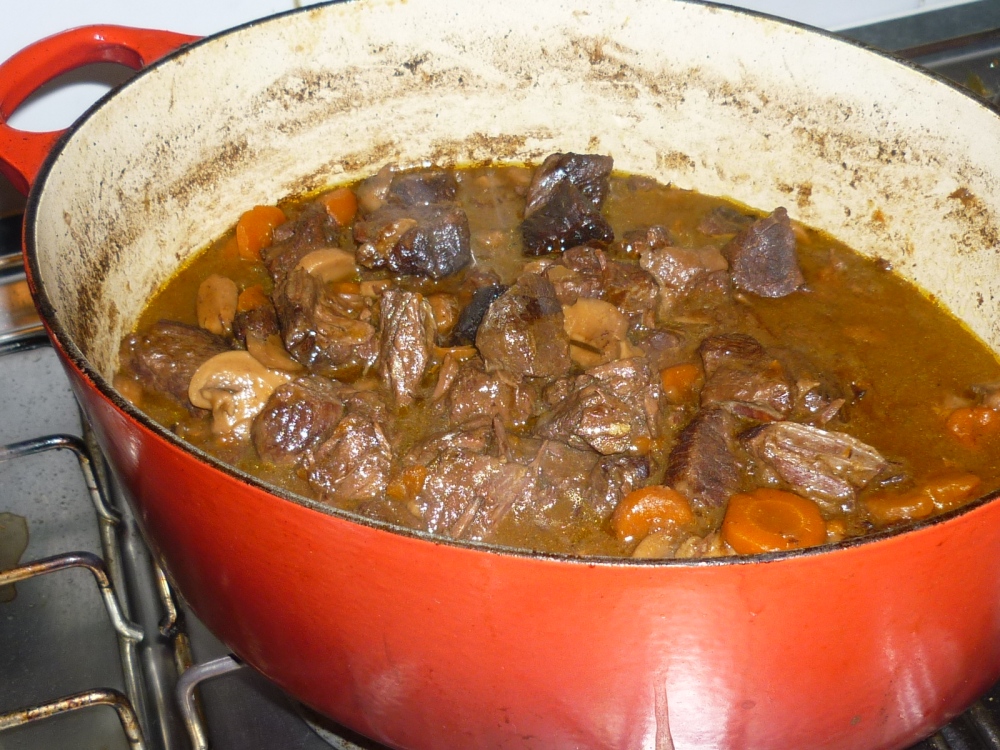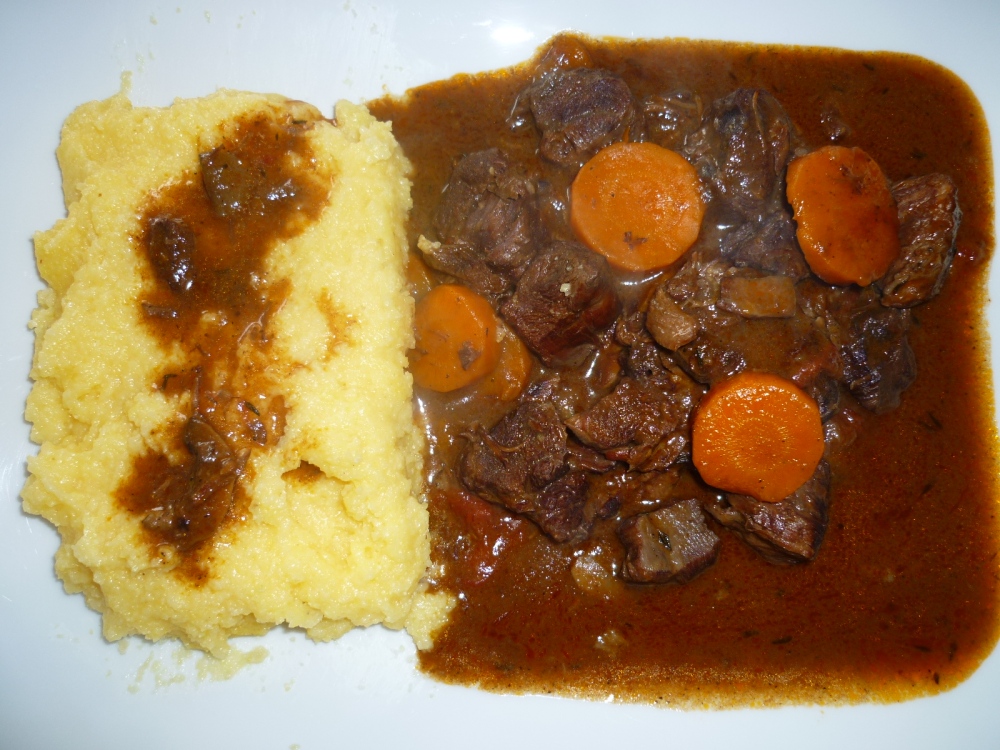Niçoise Beef Stew. That’s the best translation I can come up with, even though Daube Niçoise, our special local regional dish name, is nowadays making its way through the world. Slightly exaggerating, but this is what we do around here, for fun. I read that the dish is actually more frequently acknowledged as Daube Provençale (even in France), but the Niçoise version includes mushrooms whereas the Provençale one does not. That being said, the basics of the Daube are braised beef, a red wine based stew, local herbs and aromatics, onions, tomato, carrots and… mushrooms. I see you coming, but no, you will not be calling this a Bourguignon. It looks like it, but it’s not it. The Daube beef marinates overnight in red wine before it’s braised, while the Bourguignon beef does not go through the wine marinade step.

In Nice, like very often when it comes to traditional dishes, one could say that there is almost as many versions of Daube Niçoise as there are Niçoises families. Traditionally , it is served over polenta, or tagliatelles, or even gnocchi that we love here in Nice. This typically is a dish that is served for a family Sunday lunch. My recipe is based on my husband’s recipe that originally included tomato (as it should), except that time after time I ended up removing the tomato, sometimes for convenience, sometimes because I just forgot it, and now because I decided I liked my Daube either way. Nevertheless, I keep calling this dish La Daube de Jérôme.

In many cases when it comes to stews, it often is even better to eat it on the second day, reheated. The flavors keep developing, and the meat gets more tender. I said previously that the Daube Niçoise requires marinating into wine from the night before, therefore we usually eat it already on the second day. If you follow my advice, you’ll figure out as I did that the Daube Niçoise is really nice on the third day. The only challenge is to resist eating it all until then. Therefore, I’d say that you got only one smart option: prepare a large enough quantity of Daube so that you can eat some on the second and the third day!

INGREDIENTS (for 6 generous portions)
- About 1,5kg of beef for Bourguignon
- 1 bottle of red wine for cooking (1 bottle of the same red wine for drinking!)
- Tap water
- 2 yellow onions
- 4 carrots
- 150 grams of mushrooms
- 3 medium garlic cloves
- 1 orange
- 1/2 can of peeled tomatoes or tomato purée (optional)
- olive oil (quantity to cover the bottom of the cast iron simmer pot)
- a bit of flour
- 1 bouquet-garni
- salt and pepper
DIRECTIONS
- On the night before, prepare the meat by cutting it in chunks of about 3 cm.
- Put the meat in a large bowl, salt and pepper.
- Thinly slice the orange, quarter each slice, and add to the bowl. It’s important that the slices are thin because half of them will not be removed from the stew (that’s Jerome’s secret ingredient).
- Cover it all with red wine (not the whole bottle, just stop when it’s all covered as the rest will be used on the second day to finalize the stew).
- Protect with a plastic film and reserve in the fridge overnight.
- On the big day, get the meat out of the fridge when you start preparing the vegetables.
- Mince the onions and garlic, slice the carrots and mushrooms (about 5mm).
- Heat olive oil in a cast iron simmer pot. Braise the beef on all sides, in two batches, and reserve in another large bowl.
- Keep the wine from the first bowl, but discard about half of the orange slices.
- When all the beef is braised and reserved, keep the juices in the simmer pot, add a bit of olive oil, and start cooking the onions, garlic, carrots and mushrooms.
- While the veggies are cooking up, thoroughly flour the beef chunks.
- Put the beef back into the simmer pot and immediately add the wine from the bowl.
- Pour the wine from the bottle, and the tomato purée if using.
- Add water to the pot, so that the beef is entirely covered up.
- Throw in the bouquet-garni.
- Put the simmer pot lid on. Bring to a boil, then let it all simmer on low flame for a total of 5 hours for an optimal result. You will need to stay around, as it’s mandatory to stir and add water all along in order to keep the beef completely covered up. I sometimes choose to let the stew simmer for 3 hours at night, then finish with the last 2 hours of simmering on the next morning. Adjust seasoning with salt and pepper at this step. Serve warm for lunch (the simmer pot does not go to the fridge during that night though).
- Prepare the side whenever you’re ready to go and eat.
- Serve warm. Reheat for the next meal if you still have left-overs.
Created and Written by Sophie Rebibo-Halimi, © 2017 All Rights Reserved.

That is a cool looking Daube my friend. Sending you loadza love from Ireland :)
LikeLike
Hi Sophie, I can see this would be a fabulous dish for meat lovers. I love food the second day and I think Indian food for me is just that but this recipe would be great as you say day two AND three.
LikeLiked by 1 person
Right, anything stew-like works out really well the next days! Mmmm I hadn’t had Indian food for a while, this gives me some (spiced) ideas :)
LikeLiked by 1 person